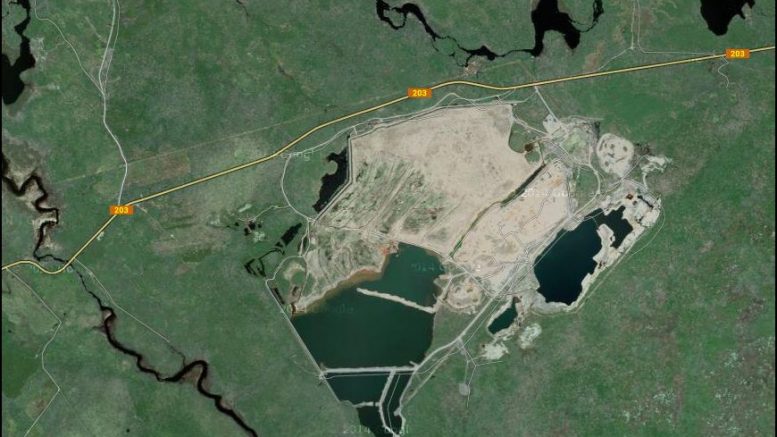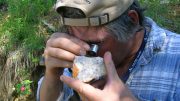Although many of the mineral deposits in Atlantic Canada are on the smaller side, the region is nonetheless home to dozens of junior explorers and developers with active programs in precious and base metals. Below is a sampling of eight such juniors.
AVALON ADVANCED MATERIALS
Don Bubar-led Avalon Advanced Materials (TSX: AVL; US-OTC: AVLNF) is focused on its Separation Rapids hard-rock lithium project in northwestern Ontario and Nechalacho rare earth elements project in the Northwest Territories, but it also has a third advanced materials project: the East Kemptville tin-indium project east of Yarmouth, Nova Scotia.
The property hosts the former East Kemptville mine, which was North America’s only primary tin producer while it was in production from 1985 to 1992. A 10,000-tonne-per-day on-site mill was subsequently removed, and the open pit flooded.
According to a 2014 estimate, East Kemptville still hosts an indicated resource of 18.5 million tonnes grading 0.18% tin, 0.17% zinc and 0.06% copper. Another 17 million tonnes at slightly lower grades lie in the inferred category.
The resource is based on 275 holes totalling 29,600 metres drilled between 1979 and 2001 by previous operators, and seven holes totalling 984 metres drilled by Avalon in 2014.
In 2015, Avalon finished a conceptual redevelopment study to restart production at 10,000 tonnes per day, and in 2016 optimized the gravity-processing flowsheet, and revisited the 7 million tonnes of stockpiled mined material still on-site.
In mid-2017, Avalon was negotiating with surface landholders for the transfer of full tenure over surface rights, and was contemplating building a small-scale operation at the site to target the stockpiles.
CANADIAN ZINC

Location map of Canadian Zinc’s South Tally Pond polymetallic project in central Newfoundland, which includes the Lemarchant deposit. Credit: Canadian Zinc.
Canadian Zinc (TSX: CZN; US-OTC: CZICF) is best known for its efforts to redevelop the Prairie Creek silver and base metals mine in the Northwest Territories, but it also has a 500 sq. km portfolio of precious and base metal properties in central Newfoundland, cobbled together via the acquisitions of Paragon Minerals and Messina Minerals in 2012–2013.
These include the South Tally Pond project (Lemarchant deposit); Tulks South project (Boomerang-Domino and Tulks East deposits) and Long Lake project (Long Lake deposit).
The Toronto-based company says its strategy in Newfoundland is to build up a resource large enough to sustain a stand-alone mine, or several smaller deposits that could be developed simultaneously and processed in a central mill.
In July, Canadian Zinc resumed drilling at its top-priority Lemarchant massive sulphide deposit, with a 24-hole program totalling 5,000 metres. Drilling returned highlight intercepts such as 14.06% zinc, 6.27% lead, 1.88% copper, 382.9 grams silver and 2.01 grams gold per tonne over 6 metres in hole 17-116.
Its current drilling includes initial drill testing of previously defined electromagnetic geophysical anomalies at the North and South Lemarchant target areas, located 500 metres along strike of the Lemarchant deposit.
At the end of March, Canadian Zinc had a positive working capital balance of $7.3 million, including cash and equivalents of $7.7 million.
EL NINO VENTURES

An undated photo of the Murray Brook pit in New Brunswick’s Bathurst base metals camp. Credit: El Nino Ventures.
Vancouver-based, Harry Barr-led El Nino Ventures (TSXV: ELN; US-OTC: ELNOF) is a base metals exploration company focused on early-stage projects in New Brunswick. For years, El Nino focused on its Murray Brook venture in the Bathurst camp with Brazil’s Votorantim, whereby El Nino owned 32.5% and Votorantim owns the rest, and is operator.
As of June 2013, Murray Brook’s in-pit measured and indicated resources stood at 1.3 million measured and indicated tonnes of oxide material grading 2.57% zinc, 0.84% lead, 0.93% copper, 38.4 grams silver per tonne and 0.38 gram gold per tonne, plus 17.9 million measured and indicated tonnes of sulphide material at 2.73% zinc, 0.99% lead, 0.47% copper, 41.7 grams silver and 0.59 gram gold.
A preliminary economic assessment carried out in June 2013 for Murray Brook calculated a $60-million net present value at a 7% discount rate, a 11.4% internal rate of return and a 5.4-year payback.
In October 2016, El Nino struck a deal to sell its stake in Murray Brook to Puma Exploration (TSXV: PUM), but closing the deal was delayed well into 2017. In May 2017, the deal was modified so that payments totalling $1.5 million would be delayed to April 2018. Puma also issued 3 million shares to El Nino.
El Nino’s remaining play in the Bathurst camp is its early-stage Bathurst Option Joint Venture project, which is equally owned by El Nino and Glencore (LON: GLEN).
EXPLOR RESOURCES

Standing outside ore processing facilities at Heath Steele Mines in northeastern New Brunswick in 1993. Credit: BR Walker -WikiCommons.
Based in Rouyn-Noranda, Explor Resources (TSXV: EXS; US-OTC: EXSFF) is looking for gold in the Abitibi greenstone belt in Quebec and Ontario, but it is also on the hunt for base metals in New Brunswick.
Its leading project in New Brunswick is its Chester copper property (formerly known as the Clearwater project), located 24 km southwest of the former Heathe Steele mine.
Explor says the Chester property is known to host a copper deposit and a volcanogenic massive sulphide. There are three zones in the main copper deposit, named Central, East and West (also known as Copper Stringer). Only the West zone is included in a National Instrument 43-101 resource calculation, which stands at 712,000 measured and indicated tonnes grading 1.94% copper, 0.09% zinc and 4.9 grams silver per tonne, plus an inferred resource of 920,000 tonnes grading 1.76% copper (the inferred material was assayed for copper only).
In March, Explor reported the results of a 12-hole drill program at Chester, with highlight hole 1571-16-4 returning 11.5 metres (from 132 metres) grading 2.36% copper, plus minor gold, silver, zinc and lead.
Explor president Chris Dupont said in a release that multiple copper mineralized zones in each of the holes drilled is “significant in terms of exploration,” and that the increase in strike length of the known mineralization from 500 to 750 metres “confirms the potential to significantly increase the resource,” which remains open on strike west and northwest.
In April, Explor closed a $900,000 private placement of flow-through shares and unsecured convertible debentures, with funds directed mainly to its Abitibi projects.
GALWAY METALS

A gold-bearing shear zone in the West Zone of the Clarence Stream gold property, 70 km south west of Fredericton, New Brunswick. Credit: Wolfden Resources.
Galway Metals (TSXV: GWM; US-OTC: GAYMF) was spun out of Galway Resources after it was sold for US$340 million in 2012, with substantially the same management team and board of directors.
Galway Metals has three high-grade gold properties in New Brunswick and Quebec, with its flagship asset being the Clarence Stream project, 70 km southwest of Fredericton in southwest New Brunswick.
Galway describes Clarence Stream as comprising 45 km of strike length of the Sawyer Brook fault system and straddling several intrusives, which may have created the conditions for gold deposition at Clarence Stream.
The property hosts an indicated resource of 822,000 tonnes grading 6.90 grams gold per tonne for 182,000 contained oz. gold, plus 1.2 million inferred tonnes of 6.34 grams gold for 250,000 contained oz. gold. Antimony is also present on the property.
Galway has carried out several deals and staked its own ground to assemble its Clarence Stream asset, but the pivotal agreement is an option to acquire 100% of Wolfden Resources’ (TSXV: WLF; US-OTC-WLFFF) interest in the Clarence Stream property for staged payments totalling $3.25 million and a 1% net smelter return royalty.
Galway has been drilling Clarence Stream since November 2016, and has so far released results for 57 holes.
In July, Galway released results from stepout drilling highlighted by an intersection of 14.6 grams gold over 10.2 metres and 7.3 grams gold over 4.6 metres from near surface at the Clarence Stream North zone.
Galway has hired SRK Consulting to calculate a pit-constrained resource estimate and update the underground resource, with the numbers expected in September.
MARATHON GOLD

Marathon Gold prospector David Galley examining visible gold in coarse cubic pyrite from large quartz-tourmaline-pyrite at the Sprite gold deposit in central Newfoundland. Credit: Marathon Gold.
Toronto-based Marathon Gold (TSX: MOZ; US-OTC: MGDPF) is advancing its wholly owned Valentine Lake gold property in central Newfoundland. There, its near-surface, mainly pit-constrained deposits Leprechaun, Sprite, Marathon and Victory host measured and indicated resources totalling 22.6 million grading 1.91 grams gold for 1.4 million contained oz. gold, plus 8.8 million inferred tonnes at 2.24 grams gold for another 767,000 contained oz. gold.
Marathon launched into a four-rig, 60,000-metre drilling campaign in May at the Leprechaun and Marathon deposits at Valentine Lake, which the company describes as being part of a 20 km long gold system of which only “10% of the gold trend has been looked at in any great detail, with many drill targets and multiple deposits.”
As reported in July, Marathon’s latest infill drilling at the Marathon deposit, along the southwest and northeast ends of the mineralized corridor, cut 5.40 grams gold over 20 metres and 5.89 grams gold over 6 metres in hole 17-182, as well as 1.82 grams gold over 82 metres in hole 17-183.
MORIEN RESOURCES

Kameron Collieries’ Donkin coal mine in Cape Breton, Nova Scotia. Credit: Kameron Collieries

The Donkin coal project in Nova Scotia, which is owned by Kameron Collieries, a Cline Group subsidiary. Credit: Morien Resources.
Morien Resources (TSXV: MOX) has traded publicly since November 2012, after having been spun out from Mongolia-focused Erdene Resource Development (TSX: ERD).
Morien is focused on North America with two long-life royalty assets, an active project generation program and a strong cash position.
Its most notable asset is its royalty on the Donkin underground coking and thermal coal mine in Cape Breton, which is owned and operated by Kameron Collieries, a subsidiary of U.S.-based and privately held Cline Group.
Morien’s royalty is 2% on the first 500,000 tonnes in any calendar quarter and 4% on any production above that mark.
Morien received $2 million on the closing of its deal to sell its interest in the mine to Cline in February 2015, pocketed $2 million upon first coal production and is due to receive another $1.5 million on the third anniversary of the deal in February 2018, or at first coal export.

Miners pose to mark the occasion of first coal in February 2017 at Kameron Collieries’ Donkin coal mine in Nova Scotia. Credit: Kameron Collieries.
In a June 2017 update, Morien said Kameron is anticipating production of 350,000 to 450,000 tonnes in 2017, 1.2 to 1.8 million tonnes in 2018, and 2.6 to 2.75 million tonnes of salable coal in 2019.
It noted 64 full-time employees and contractors were working on-site at Donkin in June, and Kameron forecasts 135 full-time workers on-site at full production.
In July, Morien reported it had received its first royalty payment on Donkin covering April 1 to June 30, 2017. Morien said the amount was nominal, but it signalled the first sale of Donkin coal to third parties.
NEW MILLENNIUM IRON

A drill rig in 2012 at New Millennium Iron’s Taconite iron ore project in the Labrador Trough. Credit: New Millennium Iron.
Montreal-based New Millennium Iron (TSX: NML) has been exploring and developing iron ore in Canada’s Labrador Trough since 2003, and now has India’s Tata Steel as its largest shareholder and strategic partner.
New Millennium has seven long-life, National Instrument 43-101 compliant taconite properties, which its says are capable of producing high-quality products to help steelmakers worldwide. The junior also has a minority interest in a direct-shipping ore project that produces and ships sinter fines.
These properties are in the Menihek area, straddling the border between Labrador and Quebec, near the town of Schefferville.
In December, New Millennium president, CEO and director Robert Patzelt resigned all three positions to be replaced as CEO on an interim basis by the firm’s vice-president of marketing and corporate affairs, Ernest Dempsey.
Howard Lutley was appointed New Millennium chairman in May 2016, and much of the company’s focus has been on reining in expenses ahead of any resurgence in the iron ore sector. Since October 2014, the junior’s workforce has been reduced by 80%, with annualized payroll savings of $3.5 million.






Be the first to comment on "East Coast Snapshot: Eight juniors on the hunt in Atlantic Canada"